

Io9. NASA Discovers Hidden Portals In Earth’s Magnetic Field. Our planet has come a long way in scientific breakthroughs and discoveries.
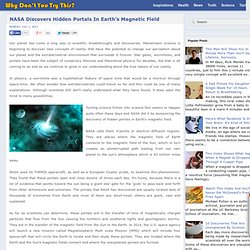
Mainstream science is beginning to discover new concepts of reality that have the potential to change our perception about our planet and the extraterrestrial environment that surrounds it forever. NASA sheds some light on Jupiter’s mysterious companion asteroids. That sound you hear is Pluto laughing...
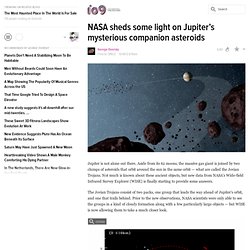
The IAU definition of "clearing the neighbourhood" used to dwarf Pluto has some conditions, namely that the orbit doesn't have to be completely clear as long as the other objects are satellites or under the gravitational dominance of the planet. Jupiter clearly controls its Trojan asteroids, so it's still a planet. Mars rover Curiosity finds signs of ancient stream. Snow on Mars: NASA Spacecraft Spots 'Dry Ice' Snowflakes.
A spacecraft orbiting Mars has detected carbon dioxide snow falling on the Red Planet, making Mars the only body in the solar system known to host this weird weather phenomenon.

The snow on Mars fell from clouds around the planet's south pole during the Martian winter spanning 2006 and 2007, with scientists discovering it only after sifting through observations by NASA's Mars Reconnaissance Orbiter (MRO). The Martian south pole hosts a frozen carbon dioxide — or "dry ice" — cap year-round, and the new discovery may help explain how it formed and persists, researchers said.
"These are the first definitive detections of carbon-dioxide snow clouds," lead author Paul Hayne, of NASA's Jet Propulsion Laboratory (JPL) in Pasadena, Calif., said in a statement. "We firmly establish the clouds are composed of carbon dioxide — flakes of Martian air — and they are thick enough to result in snowfall accumulation at the surface. " Space Sugar Discovered Around Sun-Like Star. What a sweet cosmic find!
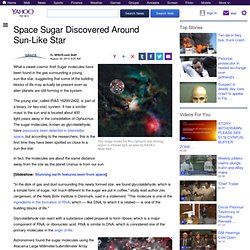
Guns in Space, and How to Kill Our Sun. NASA rover Curiosity makes historic Mars landing, beams back photos. PASADENA, California (Reuters) - NASA's Mars science rover Curiosity performed a daredevil descent through pink Martian skies late on Sunday to clinch an historic landing inside an ancient crater, ready to search for signs the Red Planet may once have harbored key ingredients for life.

Mission controllers burst into applause and cheers as they received signals confirming that the car-sized rover had survived a perilous seven-minute descent NASA called the most elaborate and difficult feat in the annals of robotic spaceflight. Engineers said the tricky landing sequence, combining a giant parachute with a rocket-pack that lowered the rover to the Martian surface on a tether, allowed for zero margin for error. "I can't believe this. This is unbelievable," enthused Allen Chen, the deputy head of the rover's descent and landing team at the Jet Propulsion Laboratory near Los Angeles. "It's an enormous step forward in planetary exploration. Apollo Moon Landing Flags Still Standing, Photos Reveal. 1st Photos from New Discovery Channel Telescope Unveiled. A privately funded telescope has taken its first images, capping off a two decades-long quest to construct the facility for research and public engagement.

The Discovery Channel Telescope is an observatory with a 14-foot (4.3-meter) mirror built near Happy Jack, Ariz., by the Lowell Observatory and Discovery Communications, the parent company of television's Discovery Channel. The telescope's opening was marked with a gala on Saturday (July 21) at Lowell Observatory in Flagstaff and featured a keynote speech from Neil Armstrong, the first person ever on the moon.
[Slideshow: Satellite captures stunning images of Earth] 1969 Fireball Meteorite Reveals New Ancient Mineral. A fireball that tears across the sky is not just a one-time skywatching event — it can reap scientific dividends long afterward.

In fact, one that lit up Mexico's skies in 1969 scattered thousands of meteorite bits across the northern Mexico state of Chihuahua. And now, decades later, that meteorite, named Allende, has divulged a new mineral called panguite. 40 Million Stars Mapped in New Night Sky Census. Astronomers are mapping more than 40 million stars in the sky, recording the brightness and location of many faint stars that will be catalogued accurately for the first time, researchers say.
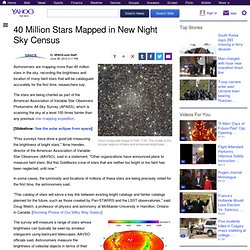
Transit of Venus. How to Safely Watch the Transit of Venus on Tuesday. Many people are planning to watch the transit of Venus on Tuesday (June 5), but it's extremely important that prospective viewers be warned to take special precautions (as with a solar eclipse) to view the silhouette of Venus against the brilliant disk of the sun.
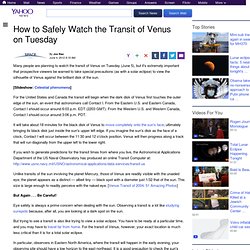
[Slideshow: Celestial phenomena] How alcohol is formed naturally in space. - StumbleUpon. 2012 March 12 - The Scale of the Universe Interactive. Discover the cosmos!

Each day a different image or photograph of our fascinating universe is featured, along with a brief explanation written by a professional astronomer. 2012 March 12 The Scale of the Universe - Interactive Flash Animation Credit & Copyright: Cary & Michael Huang. Photopic Sky Survey. Why Youll Never Escape From A Black Hole : Starts With A Bang. “They say ‘A flat ocean is an ocean of trouble. And an ocean of waves… can also be trouble.’ So, it’s like, that balance. You know, it’s that great Oriental way of thinking, you know, they think they’ve tricked you, and then, they have.”
What would happen if I drilled a tunnel through the center of th& Want to really get away from it all? The farthest you can travel from home (and still remain on Earth) is about 7,900 miles (12,700 kilometers) straight down, but you'll have to journey the long way round to get there: 12,450 miles (20,036 kilometers) over land and sea. Why not take a shortcut, straight down? You can get there in about 42 minutes -- that's short enough for a long lunch, assuming you can avoid Mole Men, prehistoric reptiles and underworld denizens en route. Granted, most Americans would end up in the Indian Ocean, but Chileans could dine out on authentic Chinese, and Kiwis could tuck into Spanish tapas for tea [sources: NOVA; Shegelski].